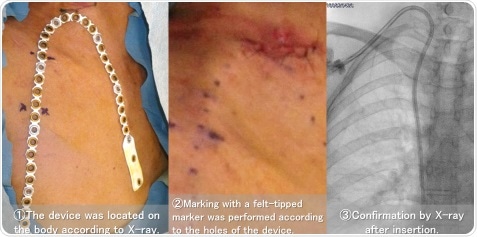Aug 15 2018
Researchers at Okayama University report in The Journal of Vascular Access a supporting device for accurately placing hemodialysis catheters on kidney patients. The device was successfully used on a group of 10 patients and is expected to become an essential tool in situations where other, catheter-free hemodialysis approaches are not possible.

Insertion support device facilitating tunneled cuffed catheter placement on kidney patients.
Patients with improperly functioning kidneys often need to undergo hemodialysis — the procedure of purifying blood in an artificial kidney outside the body — on a regular basis. Hemodialysis requires access to blood vessels, for the collection of blood and its re-introduction after purification. In this context, vascular access is commonly achieved with a so-called tunneled cuffed catheter (TCC). Accurate TCC placement is important; incorrect positioning can lead to blood clots and induce central vein thrombosis. Assistant Professor Toshiaki Ohara from Okayama University and colleagues have now developed a device enabling accurate TCC placement. The researchers’ insertion support device accommodates for individual body shape differences and is expected to decrease the rate of TCC replacements — typically ranging between 8.9% and 56%.
The device was made from a material called expanded polytetrafluoroethylene (ePTFE), having the property of maintained plasticity. It can be described as a bendable ribbon with holes (eyelets) spaced 1 cm apart; the holes allow making markings on the patient’s body with a felt-tip pen.
The insertion support device was tested on 10 Japanese adult hemodialysis patients (6 men and 4 women with a mean age of 71.3 years) treated at Shigei Medical Research Hospital. Placement of the device on the body took place with the help of X-ray imaging: the tip of the device, for marking the TCC entry site, was laid so that it overlaps with the right heart border. With the help of the markings made on the patient’s body, the physician could insert the TCC within an error of about 1 cm. The patients were observed for 2 months, during which there was no catheter replacement needed.
The device of Dr.Ohara and colleagues helps to reduce catheter waste and the overall cost of hemodialysis. In addition, as the attachment of a catheter requires exposure to X-rays, it reduces accumulated radiation doses for both patients and physicians. Although the study was only carried out for 10 patients in a short observation period, the scientists “anticipate that this new device … can be used for catheter intervention in many fields”.